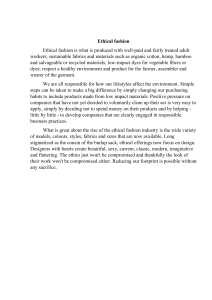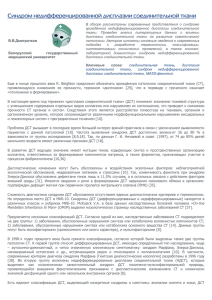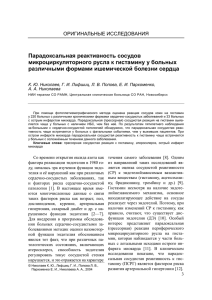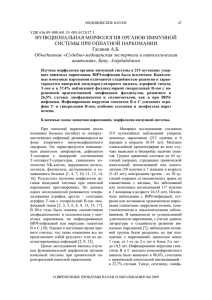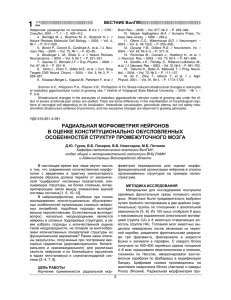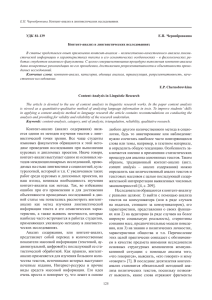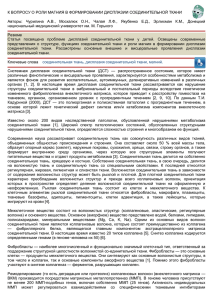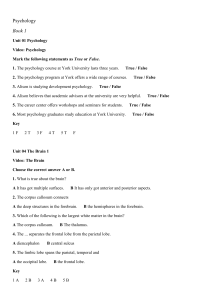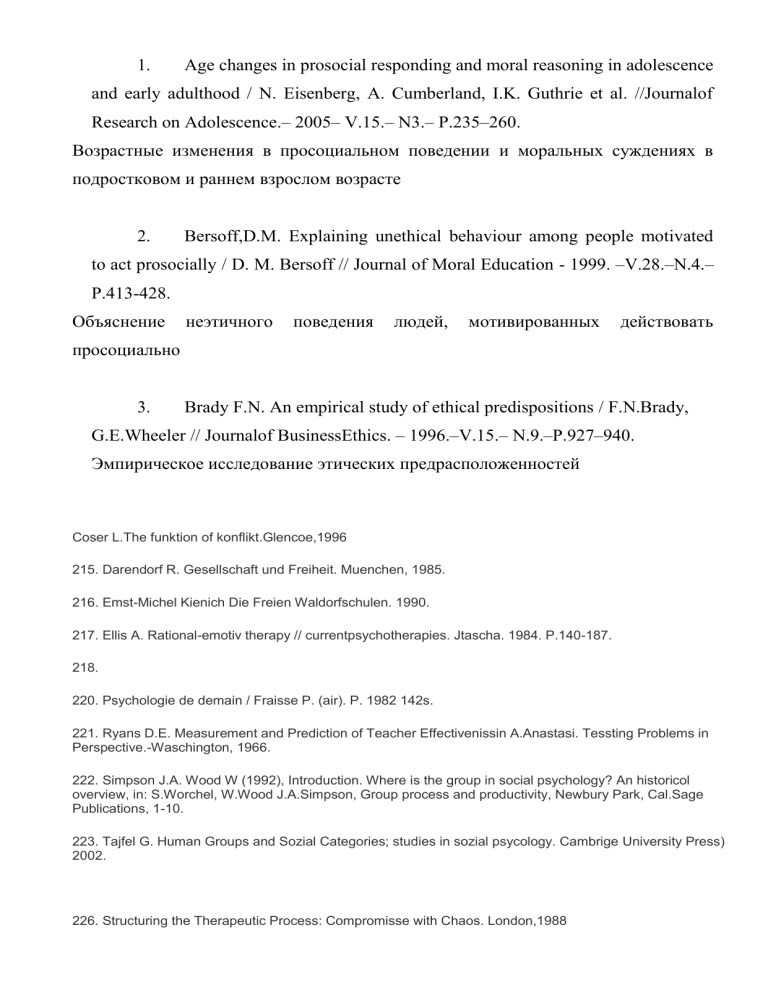
1. Age changes in prosocial responding and moral reasoning in adolescence and early adulthood / N. Eisenberg, A. Cumberland, I.K. Guthrie et al. //Journalof Research on Adolescence.– 2005– V.15.– N3.– P.235–260. Возрастные изменения в просоциальном поведении и моральных суждениях в подростковом и раннем взрослом возрасте 2. Bersoff,D.M. Explaining unethical behaviour among people motivated to act prosocially / D. M. Bersoff // Journal of Moral Education - 1999. –V.28.–N.4.– P.413-428. Объяснение неэтичного поведения людей, мотивированных действовать просоциально 3. Brady F.N. An empirical study of ethical predispositions / F.N.Brady, G.E.Wheeler // Journalof BusinessEthics. – 1996.–V.15.– N.9.–P.927–940. Эмпирическое исследование этических предрасположенностей Coser L.The funktion of konflikt.Glencoe,1996 215. Darendorf R. Gesellschaft und Freiheit. Muenchen, 1985. 216. Emst-Michel Kienich Die Freien Waldorfschulen. 1990. 217. Ellis A. Rational-emotiv therapy // currentpsychotherapies. Jtascha. 1984. P.140-187. 218. 220. Psychologie de demain / Fraisse P. (air). P. 1982 142s. 221. Ryans D.E. Measurement and Prediction of Teacher Effectivenissin A.Anastasi. Tessting Problems in Perspective.-Waschington, 1966. 222. Simpson J.A. Wood W (1992), Introduction. Where is the group in social psychology? An historicol overview, in: S.Worchel, W.Wood J.A.Simpson, Group process and productivity, Newbury Park, Cal.Sage Publications, 1-10. 223. Tajfel G. Human Groups and Sozial Categories; studies in sozial psycology. Cambrige University Press) 2002. 226. Structuring the Therapeutic Process: Compromisse with Chaos. London,1988 4. Butterfield, K. D. Moral awareness in business organizations: Influenceof issue-related and social context factors / K. D. Butterfield, L. K. Trevino, G. R.Weaver.–Human Relations.– 2000 – V.53. – N.7.– P.981–1018. 5. Clarkeburn, H. A test for ethical sensitivity in science/ H. Clarkeburn //Journalof MoralEducation.–2002 – V.31. –N.4.– P.440–453. 6. Dolgoff, R. Ethical decisions for social work practice. - 7th ed. / R.Dolgoff, D. Harrington, F. M. Loewenberg. – Belmont, C.A.: Thomson Brooks/Cole,2005.– 285p. 7. Douglas,S.ClinicalDilemmasinPsychotherapy:ATranstheoreticalApproac htoPsychotherapyIntegration/S.Douglas.–N.Y.:Hardcover,2005.–p.255 8. Eisenberg,N.Emotion,regulation,andmoraldevelopment/N.Eisenberg//An n.Rev.Psychol. – 2000. – V.51. – P.665–697. 9. Erwin, W. J. Supervisor moral sensitivity. / Erwin, W. J. // CounselorEducation and Supervision.– 2000. –V.40. – P.115–127. 10. Ethical Ambiguities in the Practice of Child Clinical Psychology / С. I.Mannheim, M. Sancilio, S. Phipps-Yonas // Professional: Research and Practice. – 2002.– V.33.– N.1. – Р.24–29. 11. Evaluating ethical sensitivity in medical students: Using vignettes as aninstrument / P Hebert, E. M. Meslin, E. V. Dunn et al. // Journal of Medical Ethics. –1990.– V.16.– N.3.– P.141–145. 12. Giorgi,A.Statusofqualitativeresearchin thehumansciences/A.Giorgi//Methods.– 1986. –V.1 –N.1.– P.29–62. 13. Gottlieb,M.AvoidingExploitiveDualRelationships:ADecision-Making Model/M.Gottlieb//Psychotherapy. – 1993.– V.30. –N.1.– P.41–48. 14. Haidt, J. When Morality Opposes Justice: Conservatives HaveMoralIntuitions that Liberals may not Recognize / Haidt J., Graham J. //Social JusticeResearch.–2007.–V.20.–N.1.–P.98-116. 15. Increasing ethical sensitivity to racial and gender intolerance in schools :Development of the racial ethical sensitivity test. / M.M. Brabeck, L.A. Rogers, S.Selcuket al.// Ethicsand Behavior.–2000. – V.10.– N.2.–P.119-137. 16. Jordan, J. Taking the First Step Toward a Moral Action: A Review ofMoral Sensitivity Measurement Across Domains // Journal of Genetic Psychology. –2007.– V.168. – N.3.– P.323-359. 17. Karcher,J.N.Auditors’abilitytodiscernthepresenceofethicalproblems. / J. N. Karcher. // Journal of Business Ethics. – 1996 – V. 15. – P. 1033–1050. 18. Kitchener, K.S. Foundations of ethical practice in research andteachinginpsychology/K.S.Kitchener.–Mahwah,NJ:Erlbaum,2000.– 318p. 19. Kohlberg, L. The relationship of moraljudgment to moral action. L.Kohlberg, D. Candee //Essays on moral development / L. Kohlberg. - 1984:Vol.2.Thepsychologyofmoraldevelopment.- Р.498–581. 20. Kolay,A.S.EthicalDilemmasExperiencedbyPsychologicalCounsellors Working at Different Institutions and their Attitudes and Behaviours as aResponse to These Dilemmas / A. S. Kolay // Educational Sciences: Theory andPractice.–V.12.– N.3.– P.1806-1812. 21. Lind,R.A.IdentifyingpatternsofethicalsensitivityinTVnewsviewers: An assessment of some critical viewing skills. / R. A. Lind, T. SwensonLepper,D.L.Rarick//JournalofBroadcasting&ElectronicMedia.–1998.–V.42. –P.507–519. 22. Morality in everyday life / W. Hofman, D. C. Wisneski, M. J. Brandt,L.J.Skitka//Science.–2014.–V.345(6202).–P.1340-1343. 23. Myyry, L. The role of value priorities and professional ethical training inmoral sensitivity / L. Myyry, K. Helkama // Journal of Moral Education. – 2002. – V.31– P.35–50. 24. Owhoso,V.Mitigatinggender- specificsuperiorethicalsensitivity:Whenassessinglikelihoodoffraudrisk/V.Owhoso//Jo urnalofManagerialIssues. –2002.–V.14.–P.360–374. 25. Pope, K. Ethical Dilemmas Encountered by Members of the AmericanPsychological Association: A National Survey /Pope K., Vetter V.//AmericanPsychologist.– 1992.– V.47.– N.3.– P.397–411. 26. Postconventionalmoralthinking:A neo-Kohlbergianapproach/J.Rest, D.Narvaez,M.J. Bebeau,S.J.Thoma.-Mahwah,NJ:Erlbaum,1999. – 229р. 27. Robin, D. P.The perceived importance of anethical issue as an influenceon the ethical decision-making of ad managers / D. P. Robin, R. E. Reidenbach, P. J.Forrest//JournalofBusinessResearch.– 1996. –V.35.– P.17–28. 28. Sadler, T. D. Moral sensitivity and its contribution to the resolution ofsocio-scientific issues. / T. D. Sadler // Journal of Moral Education. – 2004. – V.33. –P.339–358. 29. Shaub, M. K. The effects of auditors’ ethical orientation on commitmentandethicalsensitivity. / M. K. Shaub, D. W. Finn, P. Munter, P. //BehavioralResearchinAccounting.– 1993.– V.5.– P. 145–164. 30. Smith, D. 10 ways practitioners can avoid frequent ethical pitfalls / D.Smith//MonitoronPsycholodgy.– 2003.– V.34.– N.1.– Р.50. 31. Sparks, J. R. Marketing researcher ethical sensitivity: Conceptualization,measurement, and exploratory investigation / J. R. Sparks, S. D. Hunt // Journal ofMarketing.– 1998. – V.62.– P.92–109. 32. Spinelli, E. The existential-phenomenological paradigm / E. Spinelli. //HandbookofCounsellingPsychology– 2ed.//eds.R.Woolfe,W.Dryden,S.Srawbridge– London:SAGEPublications,2003.–P.180–198. 33. Swahcon,C.D. acounselor Ethics thecounselor /С.D.Swahcon// Being /eds.J.A.Brown,R.H.Pate.– Jr.Pacifi cGroveCA:Brooks.Cole,1983.P.47–65. 34. Tjeltveit,A.Avoidingethicalmissteps/A.Tjeltveit,M.Gottlieb//M onitoronPsychology.– 2012.–V.43. – N.4.– Р.68–74. 35. Turiel,E.DevelopmentofChildren’sOrientationstowardMoral,S ocial, and Personal Orders: More than a Sequence in Development / E. Turiel //HumanDevelopment.–2008.–V.51.–N.1.–P.21–39. 198. Shaub, M. K. The effects of auditors’ ethical orientation on commitment and ethical sensitivity. / M. K. Shaub, D. W. Finn, P. Munter, P. // Behavioral Research in Accounting. – 1993. – V. 5. – P. 145–164. 199. Smith, D. 10 ways practitioners can avoid frequent ethical pitfalls / D. Smith // Monitor on Psycholodgy. – 2003. – V. 34. – N. 1. – Р. 50. 200. Sparks, J. R. Marketing researcher ethical sensitivity: Conceptualization, measurement, and exploratory investigation / J. R. Sparks, S. D. Hunt // Journal of – Marketing. – 1998. V. 62. – P. 92–109. 201. Spinelli, E. The existential-phenomenological paradigm / E. Spinelli. // Handbook of Counselling Psychology – 2ed. // eds. R. Woolfe, W. Dryden, S. Srawbridge – London: SAGE Publications, – 2003. P.180–198. 202. Swahcon, C.D. Ethics the counselor / С.D. Swahcon // Being a counselor / eds. J.A. Brown, R.H. Pate. – Jr. Pacifi c Grove CA: Brooks. Cole, 1983. P. 47– 65. 203. Tjeltveit, A. Avoiding ethical missteps / A. Tjeltveit, M. Gottlieb // Monitor on Psychology. – 2012. – V. 43. – N. 4. – Р. 68–74. 204. Turiel, E. Development of Children’s Orientations toward Moral, Social, and Personal Orders: More than a Sequence in Development / E. Turiel // Human Development. – 2008. – V.51. – N.1. – P. 21–39. Gelso С.J., Carter J.A. The relationship in counseling and psychotherapy: components, consequences and theoretical antecendents // The Counseling Psychologist, 1985. Vol. 13. P. 155243. 136. George R.L., Cristiani T.S. Counseling: Theory and Practice, 3 rd Ed., Enqle-wood Cliffs. N.J.: Prentice-Hall, 1990. 137. Gilliland B.E., James R.K., Bowman J.T. Theories and Strategies in Counseling and Psychotherapy. 2 nd Ed. Enqlewood Cliffs. N.J.: Prentice-Hall, 1989. 138. Gladstein G.A. Understanding empathy: integrating counseling, developmental and social psychology perspectives // Journal of Counseling Psychology, 1983. Vol 30. P.467-482. 139. Rogers C. The necessary and sufficient conditions of therapeutic personality change // Journal of Consultation Psychology, 1957. Vol. 21. P. 95-103. 140. Schneider K. Therapist's personal maturity and therapeutic success: how strong is the link? //The Psychotherapy Patient. 1992. Vol. 8. N 3-4. P. 71-91. 169. Age changes in prosocial responding and moral reasoning in adolescence and early adulthood / N. Eisenberg, A. Cumberland, I.K. Guthrie et al. // Journal of Research on Adolescence. – 2005 – V.15. – N 3. – P. 235–260. 170. Bebeau, M. J. Influencing the moral dimensions of dental practice. / Bebeau, M. J. // Moral Development in the Professions: Psychology and Applied Ethics / J. R. Rest, D. Narváez (eds.). – L.: Erlbaum Associates,1994. – Р. 121-146. 171. Bersoff, D.M. Explaining unethical behaviour among people motivated to act prosocially / D. M. Bersoff // Journal of Moral Education 1999. – V.28. – N. 4. – P. 413-428. 172. Brady, F. N. An empirical study of ethical predispositions / F.N. Brady, G. E. Wheeler // Journal of Business Ethics. – 1996. – V. 15. – N.9. – P. 927–940. 173. Butterfield, K. D. Moral awareness in business organizations: Influence of issue-related and social context factors / K. D. Butterfield, L. K. Trevino, G. R. Weaver. – Human Relations. – 2000 – V. 53. – N.7. – P. 981–1018. 174. Clarkeburn, H. A test for ethical sensitivity in science / H. Clarkeburn // Journal of Moral Education. – 2002 – V. 31. – N. 4. – P. 440–453. 175. Dolgoff, R. Ethical decisions for social work practice. - 7th ed. / R. Dolgoff, D. Harrington, F. M. Loewenberg. – Belmont, C.A.: Thomson Brooks/Cole, 2005. – 285 p. 176. Douglas, S. Clinical Dilemmas in Psychotherapy: A Transtheoretical Approach to Psychotherapy Integration / S. Douglas. – N.Y.: Hardcover, 2005. – p. 255 177. Eisenberg, N. Emotion, regulation, and moral development / N. Eisenberg // Ann. Rev. Psychol. – 2000. – V. 51. – P. 665–697. 178. Erwin, W. J. Supervisor moral sensitivity. / Erwin, W. J. // Counselor Education and Supervision. – 2000. – V. 40. – P. 115–127. 179. Ethical Ambiguities in the Practice of Child Clinical Psychology / С. I. Mannheim, M. Sancilio, S. Phipps-Yonas // Professional: Research and Practice. – 2002. – V. 33. – N.1. – Р. 24–29. 180. Evaluating ethical sensitivity in medical students: Using vignettes as an instrument / P Hebert, E. M. Meslin, E. V. Dunn et al. // Journal of Medical Ethics. – 1990. – V. 16. – N. 3. – P. 141–145. 181. Giorgi, A. Status of qualitative research in the human sciences / A. Giorgi // Methods. – 1986. – V. 1 – N. 1. – P. 29–62. 182. Gottlieb, M. Avoiding Exploitive Dual Relationships: A DecisionMaking Model / M. Gottlieb // Psychotherapy. – 1993. – V. 30. – N. 1. – P. 41–48. 183. Haidt, J. When Morality Opposes Justice: Conservatives Have Moral Intuitions that Liberals may not Recognize / Haidt J., Graham J. // Social Justice Research. – 2007. – V.20. – N. 1. – P. 98-116. 184. Increasing ethical sensitivity to racial and gender intolerance in schools : Development of the racial ethical sensitivity test. / M.M. Brabeck, L.A. Rogers, S. Selcuk et al. // Ethics and Behavior. – 2000. – V. 10. – N. 2. – P. 119-137. 185. Jordan, J. Taking the First Step Toward a Moral Action: A Review of Moral Sensitivity Measurement Across Domains // Journal of Genetic Psychology. – 2007. – V. 168. – N. 3. – P. 323-359. 186. Karcher, J. N. Auditors’ ability to discern the presence of ethical problems. / J. N. Karcher. // Journal of Business Ethics. – 1996 – V. 15. – P. 1033– 1050. 187. Kitchener, K.S. Foundations of ethical practice in research and teaching in psychology / K. S. Kitchener. – Mahwah, NJ: Erlbaum, 2000. – 318 p. 188. Kohlberg, L. The relationship of moral judgment to moral action. L. Kohlberg, D. Candee //Essays on moral development / L. Kohlberg. 1984:- Vol. 2.The psychology of moral development. - Р. 498–581. 189. Kolay, A. S. Ethical Dilemmas Experienced by Psychological Counsellors Working at Different Institutions and their Attitudes and Behaviours as a Response to These Dilemmas / A. S. Kolay // Educational Sciences: Theory and Practice. – V. 12. – N. 3. – P. 1806-1812. 190. Lind, R. A. Identifying patterns of ethical sensitivity in TV news viewers: An assessment of some critical viewing skills. / R. A. Lind, T. Swenson- Lepper, D. L. Rarick // Journal of Broadcasting & Electronic Media. – 1998. – V. 42. – P. 507–519. 191. Morality in everyday life / W. Hofman, D. C. Wisneski, M. J. Brandt, L.J. Skitka // Science. – 2014. – V. 345(6202). – P. 1340-1343. 192. Myyry, L. The role of value priorities and professional ethical training in moral sensitivity / L. Myyry, K. Helkama // Journal of Moral Education. – 2002. – V.31 – P. 35–50. 193. Owhoso, V. Mitigating gender-specific superior ethical sensitivity: When assessing likelihood of fraud risk / V. Owhoso // Journal of Managerial Issues. – 2002. – V. 14. – P. 360–374. 194. Pope, K. Ethical Dilemmas Encountered by Members of the American Psychological Association: A National Survey / Pope K., Vetter V. // American Psychologist. – 1992. – V. 47. – N. 3. – P. 397–411. 195. Postconventional moral thinking: A neo-Kohlbergian approach / J. Rest, D. Narvaez, M. J. Bebeau, S. J. Thoma. - Mahwah, NJ: Erlbaum,1999. – 229 р. 196. Robin, D. P.The perceived importance of anethical issue as an influence on the ethical decision-making of ad managers / D. P. Robin, R. E. Reidenbach, P. J. Forrest //Journal of Business Research. – 1996. – V. 35. – P. 17–28. 197. Sadler, T. D. Moral sensitivity and its contribution to the resolution of socio-scientific issues. / T. D. Sadler // Journal of Moral Education. – 2004. – V.33. – P. 339–358. 135. Gelso С.J., Carter J.A. The relationship in counseling and psychotherapy: components, consequences and theoretical antecendents // The Counseling Psychologist, 1985. Vol. 13. P. 155-243. 136. George R.L., Cristiani T.S. Counseling: Theory and Practice, 3 rd Ed., Enqlewood Cliffs. N.J.: Prentice-Hall, 1990. 137. Gilliland B.E., James R.K., Bowman J.T. Theories and Strategies in Counseling and Psychotherapy. 2 nd Ed. Enqlewood Cliffs. N.J.: Prentice-Hall, 1989. 138. Gladstein G.A. Understanding empathy: integrating counseling, developmental and social psychology perspectives // Journal of Counseling Psychology, 1983. Vol 30. P.467-482. 139. Rogers C. The necessary and sufficient conditions of therapeutic personality change // Journal of Consultation Psychology, 1957. Vol. 21. P. 95-103. 140. Schneider K. Therapist's personal maturity and therapeutic success: how strong is the link? //The Psychotherapy Patient. 1992. Vol. 8. N 3-4. P. 71-91. Lopez D. F., & Little T. D. Children’s action-control beliefs and emotional regulation in the social domain // Developmental Psychology 1996 № 32 P. 299-312. Lundgren D. C., Schwab M. R. Perceived appraisals by others, selfesteem, and anxiety // Journal of Psychology 1977 Vol. 97 P. 205-213. Moss R. H., Schaefer J. A. Life transitions and crises // Coping with life crises. An integrative approach. New York: Plenum Press. P. 3-28. Paulhan I. Le concept de coping // Annee psychol. 1992 № 4 P. 315Pearlin L. I., Schooler C. The structure of coping / L. I. Pearlin, C. Schooler // J. of Health and Social Behavior. 1978 Vol.19. P. 2-21. Skinner E., Edge K. Reflections on Coping and Development across the lifespan // International Journal of Behavioral Development 1998 № 22(2). Spielberger C. D. Anxiety: Current trends in theory and research. N.Y., 1972 Vol. 1 P. 24-55. 100 Vitaliano P. P. et al. Coping Profiles Associated With Psychiatric, Physical Health, Work and Family Problems// Health Psychology 1990 № 9(3). 101 Zinbarg R. E., Barlow D. H., Hertz R. M. Cognitive-behavioral approaches to the nature and treatment of anxiety dis-orders // Annual Review of Psychology.1992. Vol. 43 P. 235-267. Ader R., Cohen N. Psychoneuroimmunology: conditioning and stress // Annual review of psychology.1993. Vol. 44 P. 53-85. Ayers T. S., Sandler I., West, S., & Roosa, M. W. (1996). A Dispositional and Situational Assessment of Children's Coping: Testing Alternative Models of Coping. Journal of Personality, 64(4), 923-958. Berg C.A., Meegan S. P., & Deviney P.P. A social-contextual model of coping with everyday problems across the lifespan // International Journal of Behavioral Development 1998 № 22(2). P. 231-237. Frydenberg E. Beyond Coping. Meeting goals, visions and challenges. — Oxford University Press, 2002 P. 272 Hobfoll S. E. (1996). Social Support: Will you be there when I need you? In N. Vanzetti and S. Duck (eds.), A lifetime of relationships. California: Brooks / Cole Publishing Co. Lazarus R. S. From psychological stress to the emotions: A history of changing gutlooks / R. S. Lazarus //Annual Review of Psychology. – 1993 – Vol. Lazarus R. S. Emotion and Adaptation. — New York: Oxford University Press, 1991 1. Allport F. The influence of the group upon association and thought. Journal of Experimental Psychology. 1920, 3. 2. Bernstein S. (Ed.). Explorations in group work: Essays in theory and practice. -Boston. 1973. 3. Cummins R. C., King D. C. The interaction of group size and task structure in an industrial organization. Personal Psychology. 1973. 4. Dailey R. C. The effects of cohesiveness and collaboration on work groups: Group and Organization Studies. 1977. 5. Davis J. H., Restle F. The analysis of problems and prediction of group problemsolving. Journal of Abnormal and Social Psychology. 1963. 6. Ford D. L., Nemiroff P. M., Passmore W. A. Group decision-making performanceas influenced by group tradition. Small group behavior. 1977, vol. 8. 7. Gitovich R., Kovalchuk S. Learning Psychology in English. – Moscow, 2010. https://www.book.ru/book/905361 8. Goldman M., Dietz D., Mc Glynn. Comparison of individual and groupperformance related to heterogeneous wrong responses, size and patterns ofinteraction. Psychological Reports. 1968, vol. 23, No. 2. 9. Gorchakova E., Spiridonova N. English for psychologists - Voronezh, 2003. http://window.edu.ru/resource/069/40069/files/jun03042.pdf 10. Hoffman Ch., Hendrick H. Problem solving in different sized groups. Personal Psychology. 1971, Vol. 24, 3. 11. Kanecar S., Neclakantan P. Group performance as a function of group type and group composition. Journal of Social Psychology. 1976, Vol. 6, No. 3. Kelley H. H., Thibaut J. W. Group problem solving. - In: Handbook of Social Psychology. Vol. 4, 1969. 12. Roby Т. B. Small group performance. Chicago, 1968. 13. . Shifflet S. Toward a general model of group productivity. Psychological Bulletin. 1979, Vol. 86, 1. 14. Terborg J. R., Castor C., De Ninno J. N. A longitudinal field investigation of the impact of group performance and cohesion. Journal of Personality and Social Psychology. 1976, Vol. 34, No. 5. Sample assessment tools for each type of assessment can be found at http://moodle.pnzgu.ru 7. Educational, methodological, information and technical means provided for the discipline а) Teaching and learning materials: 1. Best J.B., Addison W.E. A Preliminary Study of Perceived Warmth of Professor and Student Evaluations // Teaching of Psychology, V. 27, N 1. P. 60-62. – Win., 2000. 2. Brown D.T., Benson A. J., etc. A systemic view of higher education and professional psychology: Implications of the Combined-Integrated model of doctoral training // Journal of clinical psychology. V. 60, N 10, 2004. - New York, NY. 3. Filak V.F., Sheldon K.M. Student Psychological Need Satisfaction and College TeacherCourse Evaluations // Educational Psychology: An International Journal of Experimental Educational Psychology, V. 23, N. 3, P. 235-247. Jun., 2003. b) Internet resources: https://vk.com/away.php?to=https%3A%2F%2Fwww.frontiersin.org%2Fjournals%2Fpsycholog y&cc_key= https://www.mdpi.com/journal/education c) Software: - "Microsoft Windows" (DreamSpark subscription/Microsoft Imagine Standart); registration number 00037FFEBACF 8FD7, contract No. SD- 130712001 dated 07/12/2013; - freely distributed software: OpenOffice; Mozilla Firefox; Adobe Acrobat Reader. d) Other material and technical means: Name of special rooms and premises for in-class and individual work PSU lecture hall PSU classroom PSU classroom for individual work Equipment of special rooms and premises for in-class and individual work
